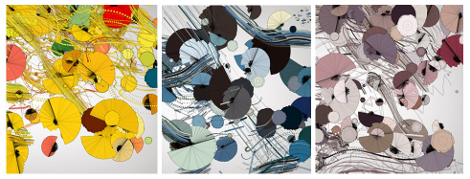
This is what your coffee looks like as it is being brewed. The three different art pieces seen above were generated based on data from different parts of a high-end coffee maker. This isn’t a bargain basement single switch drip maker (we reserve those for NES retrofits) but a top-of-the-line espresso machine. And before you cry foul we’ll warn you that the project is a marketing device for the manufacturer. But we still think it’s interesting so read on or jump directly to the video after the break.
We’re unsure if the sensors are normally included in the machine or if they were added during the hack. An Arduino pulls in data about the brew process from two flow meters, a steam indicator LED, and three thermistors. The measured values are sent to a Processing application which turns them into the generative art seen above. What results is a widescreen display that aims to turn your bleary-eyed wait for morning coffee into something interesting.
[Thanks Matthew]















Whatever
this is awesome wish my coffee maker did that id love to see that on an screen while my coffee is brewing and logging the pix id have it scrolling across my desktop background.
My face when I see better news on 4chan than on here…
For all the relevance the artwork has to the espresso, they may as well have instrumented the flow rate and pressure of a barista taking a dump.
The coffer maker is a red herring. This piece of “art” is necessarily designed independent of the coffee maker. It’s doesn’t even seem to be purely procedural. In a functional sense, it looks like predetermined shapes with superficial arguments as the front-end.
Hooray for simultaneously making Arduino and the coffee maker look even more pretentious!
Espresso in a styrofoam cup.Yikes.
As to the technical side: If I were there I would ask them about temperature. Temperature stability influences the quality of coffee in a cup more than flow rate and pressure. That’s also the hardest part in classic espresso machine design.
All those paint splatters? THAT’S the graph of temperature stability.
Yeah, but is this really random? ;-)
The lines come from a perlin noise, which is not random.
thanks.